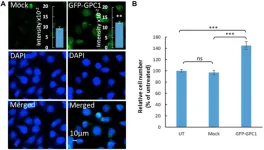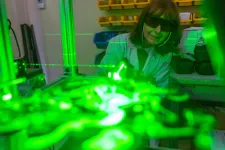(Press-News.org)
Engineers are harnessing artificial intelligence (AI) and wireless technology to unobtrusively monitor elderly people in their living spaces and provide early detection of emerging health problems.
The new system, built by researchers at the University of Waterloo, follows an individual’s activities accurately and continuously as it gathers vital information without the need for a wearable device and alerts medical experts to the need to step in and provide help.
“After more than five years of working on this technology, we’ve demonstrated that very low-power, millimetre-wave radio systems enabled by machine learning and artificial intelligence can be reliably used in homes, hospitals and long-term care facilities,” said Dr. George Shaker, an adjunct associate professor of electrical and computer engineering.
“An added bonus is that the system can alert healthcare workers to sudden falls, without the need for privacy-intrusive devices such as cameras.”
The work by Shaker and his colleagues comes as overburdened public healthcare systems struggle to meet the urgent needs of rapidly growing elderly populations.
While a senior’s physical or mental condition can change rapidly, it’s almost impossible to track their movements and discover problems 24/7 — even if they live in long-term care. In addition, other existing systems for monitoring gait — how a person walks — are expensive, difficult to operate, impractical for clinics and unsuitable for homes.
The new system represents a major step forward and works this way: first, a wireless transmitter sends low-power waveforms across an interior space, such as a long-term care room, apartment or home.
As the waveforms bounce off different objects and the people being monitored, they’re captured and processed by a receiver. That information goes into an AI engine which deciphers the processed waves for detection and monitoring applications.
The system, which employs extremely low-power radar technology, can be mounted simply on a ceiling or by a wall and doesn’t suffer the drawbacks of wearable monitoring devices, which can be uncomfortable and require frequent battery charging.
“Using our wireless technology in homes and long-term care homes can effectively monitor various activities such as sleeping, watching TV, eating and the frequency of bathroom use,” Shaker said.
“Currently, the system can alert care workers to a general decline in mobility, increased likelihood of falls, possibility of a urinary tract infection, and the onset of several other medical conditions.”
Waterloo researchers have partnered with a Canadian company, Gold Sentintel, to commercialize the technology, which has already been installed in several long-term care homes.
A paper on the work, AI-Powered Non-Contact In-Home Gait Monitoring and Activity Recognition System Based on mm-Wave FMCW Radar and Cloud Computing, appears in the IEEE Internet of Things Journal.
Doctoral student Hajar Abedi was the lead author, with contributions from Ahmad Ansariyan, Dr. Plinio Morita, Dr. Jen Boger and Dr. Alexander Wong.
END
NEW YORK, NY--Columbia researchers have discovered how a genetic defect leads to spinal muscular atrophy (SMA), a critical piece of information about the disease that neurologists have been seeking for decades.
The discovery suggests a new way to treat SMA—a devastating childhood motor neuron disease that affects 1 in 6,000 children. In the most severe cases, and when left untreated, children born with SMA die within the first two years of life.
The researchers also used their finding to develop an experimental therapy that improved survival in mice with severe SMA by ...
“This study was designed to increase the knowledge on the potential of GPCs and in particular GPC1 as a biomarker in cancer diagnosis and prognosis.”
BUFFALO, NY- March 22, 2023 – A new research paper was published in Oncotarget's Volume 14 on March 21, 2023, entitled, “Attenuation of cancer proliferation by suppression of glypican-1 and its pleiotropic effects in neoplastic behavior.”
Glypicans (GPC1-6) are associated with tumorigenic processes and their involvement in neoplastic behavior has been ...
CAMBRIDGE, Mass.—Clean geothermal energy—the heat beneath our feet—has the potential to be cost competitive with other renewables and even fossil fuels if we can drill deep enough to access the mother lode of the resource. That’s according to one speaker at a geothermal conference last month held by the Society of Petroleum Engineers (SPE). Other speakers addressed growing interest in the field by the oil and gas sector, key challenges it faces, and solutions to help solve those challenges.
Geothermal 2023: Realising the Ambition was organized by the Aberdeen, ...
When natural habitats are cleared to make way for cities, roads and agriculture, this often leaves behind “islands” of fragmented habitat that can place species at risk of extinction. Species are at risk when they find it hard to move among habitat patches to find resources and reproduce.
By combining lab experiments and mathematical modelling, researchers at McGill University and the Swiss Federal Institute of Aquatic Science and Technology have found a way to predict the movement of species that could guide conservation efforts to reconnect fragmented habitats.
The ...
Scientists have gained new insights into the part of the brain that gives us a sense of direction, by tracking neural activity with the latest advances in brain imaging techniques. The findings shed light on how the brain orients itself in changing environments – and even the processes that can go wrong with degenerative diseases like dementia, that leave people feeling lost and confused.
“Neuroscience research has witnessed a technology revolution in the last decade allowing us to ...
PHILADELPHIA – The members of the American Association for Cancer Research (AACR) have elected Patricia M. LoRusso, DO, PhD (hc), as the AACR President-Elect for 2023-2024. LoRusso will become President-Elect on Monday, April 17, during the AACR’s Annual Business Meeting of Members at the AACR Annual Meeting 2023 in Orlando, Florida. She will assume the Presidency in April 2024 at the AACR Annual Meeting in San Diego, California.
LoRusso is a professor of medicine (medical oncology); chief of experimental therapeutics; associate cancer center director for experimental therapeutics; and leader of the Phase I disease aligned research ...
EMBARGOED FOR RELEASE UNTIL 4 P.M. ET, WEDNESDAY, MARCH 22, 2023
MINNEAPOLIS – People who have low bone density may have an increased risk of developing dementia compared to people who have higher bone density, according to a study published in the March 22, 2023, online issue of Neurology®, the medical journal of the American Academy of Neurology. The study does not prove that low bone density causes dementia. It only shows an association.
“Low bone density and dementia are two conditions that commonly affect older people simultaneously, especially as bone loss often increases due to physical inactivity and poor ...
EMBARGOED FOR RELEASE UNTIL 4 P.M. ET, WEDNESDAY, MARCH 22, 2023
MINNEAPOLIS – A new study has found that people with epilepsy have an increased risk of early death and the increased risk varies depending on where they live, the number of medications they take and what other diseases they may have. The study is published in the March 22, 2023, online issue of Neurology®, the medical journal of the American Academy of Neurology.
“Our research found an increased risk even among those who do not have ...
Air flow in a room can impact the transmission of viruses like COVID-19.
A Texas A&M AgriLife Research scientist is studying how heating, ventilation and air conditioning, HVAC, system configurations and building designs could mitigate the spread of microorganisms, including viruses, that are detrimental to human health.
Maria King, Ph.D., director of the Center for Agricultural Air Quality Engineering and Science in the Department of Biological and Agricultural Engineering, recently received a $400,000, two-year National ...
BIRMINGHAM, Ala. – Memory B cells play a critical role to provide long-term immunity after a vaccination or infection. In a study published in the journal Immunity, researchers describe a distinct and novel subset of memory B cells that predict long-lived antibody responses to influenza vaccination in humans.
These effector memory B cells appear to be poised for a rapid serum antibody response upon secondary challenge one year later, Anoma Nellore, M.D., Fran Lund, Ph.D., and colleagues at the University of Alabama at Birmingham and Emory University report. Evidence from transcriptional and epigenetic profiling shows that the cells in this subset differ from ...




